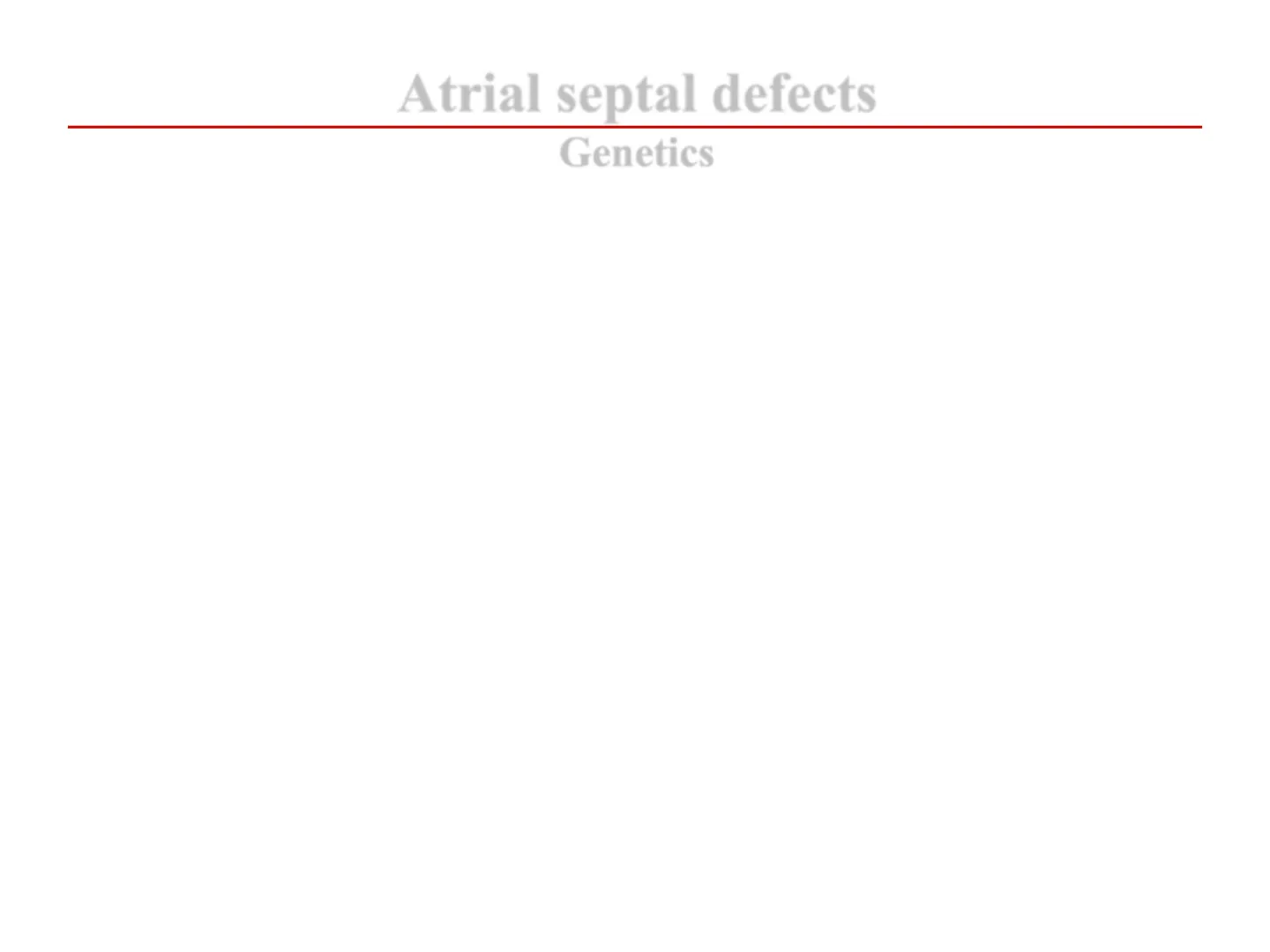Atrial Septal Defects: Genetics, Hemodynamics, and Clinical Presentation
Slides about Atrial Septal Defects. The Pdf, a presentation for university students, examines atrial septal defects (ASD), including genetic aspects, hemodynamic implications, pathophysiology, and clinical presentation. It also covers diagnostic methods like echocardiography and cardiac MRI.
See more69 Pages


Unlock the full PDF for free
Sign up to get full access to the document and start transforming it with AI.
Preview
Genetics of Atrial Septal Defects
Atrial septal defects
- A familial predisposition to ASD is well documented.
- Secundum ASD is the most common congenital cardiac defect associated with
VACTERL. - Trisomy 21 is associated with ASD either in isolation or as part of a constellation
of endocardial cushion defects. Noonan syndrome is associated with ASD and
pulmonary valve stenosis. - DiGeorge syndrome (22q11.4 deletion) is associated with primum ASD.
Types of Atrial Septal Defects
Atrial septal defects
Type of atrial septal defect
SVC
FO
TV
IVC
A Patent foramen ovale
B
Secundum defect
C
Primum defect
D Superior sinus venosus defect
E
Coronary sinus defect
Incidence and Natural History of Atrial Septal Defects
Atrial septal defects
- Secundum ASD occurs in 1.6 out of 1000 live births, second in prevalence only to
ventricular septal defect. - ASD accounts for 10% to 15% of congenital heart defects in children and 20% to 40% of
defects discovered in adults. - A significant number of ASDs close spontaneously within the first few years of life, but
spontaneous closure after age 3 to 4 is rare.
. Longitudinal data demonstrate that more than half of defects diagnosed in infancy and
measuring 4 to 5 mm close spontaneously while none close spontaneously when the defect
measures larger than 10 mm at diagnosis.
. In contrast to children with ASDs, most patients older than 40 years of age are
symptomatic and have evidence of elevated pulmonary vascular resistance. If these
patients are not treated, their average life expectancy is 40 to 50 years. Seventy-five percent
die by age 50, and 90% die by 60 years of age.
Associated Features of Atrial Septal Defects
Atrial septal defects
- Associated lesions found in the study of infants with ASD dying in the first year of life included:
Left-to-right shunting lesions
VSD or patent ductus arteriosus
Right-sided obstructive lesions
Pulmonary stenosis
Left-sided obstructive lesions
Aortic stenosis, mitral stenosis, or
coarctation of the aorta - The most common additional cardiac anomalies associated with ASD include PAPVC, persistent
left SVC and branch pulmonary artery stenosis.
Hemodynamics and Pathophysiology of Atrial Septal Defects
Atrial septal defects
Left to Right Shunt in ASD
Left to right shunt
- In early infancy, when pulmonary resistance is high, left and right ventricular compliances are
similar, and net shunting through an ASD is typically slight. - As the left ventricle matures, it becomes less compliant in diastole than the right, and left atrial
pressure rises.
ASD
Left-to-right shunt at the atrial level
- With age, the disparity between systemic and pulmonary resistance, and in turn between left and
right ventricular compliance
increased left-to-right shunting and advancing right ventricular volume loading
dilation and hypertrophy of the right ventricle, eventually affecting the function of both ventricles
Pulmonary Vascular Disease in ASD
Atrial septal defects
Pulmonary vascular disease
- Pulmonary hypertension associated with an isolated ASD is rare in childhood, although
35% to 50% of patients with unrepaired ASD have elevated pulmonary resistance by age 40. - Pulmonary hypertension can develop at an earlier age in premature infants and in children
with Trisomy 21. - Histopathologic evidence of increased preacinar and intra-acinar arterial muscularity in
infants with ASD and pulmonary vascular disease suggests
Pulmonary vasculopathy
is the primary disorder in the uncommon population with early pulmonary vascular disease.
Clinical Presentation of Atrial Septal Defects
Atrial septal defects
Clinical presentation
- A great majority of ASDs are asymptomatic, and palpitations, atrial fibrillation, and
congestive failure are late sequelae, uncommon in patients younger than 40 years of age. - Additional clinical associations with PFO include stroke, migraine headache, high altitude
pulmonary edema, and diver's decompression disease. - Recurrent respiratory infection in the presence of a large ASD is not uncommon.
Cyanosis can develop in the setting
advanced irreversible pulmonary hypertension
Diagnostics and Examination for Atrial Septal Defects
Atrial septal defects
Transthoracic Echocardiography for ASD
Transthoracic echocardiography
- Is the most accurate modality of ASD diagnosis
Small defects remain difficult to image by echo
Cardiac Magnetic Resonance Imaging for ASD
- Cardiac magnetic resonance imaging (MRI)
Is useful in imaging partial anomalous pulmonary venous structures that may lie adjacent to the
airways and lung.
Right SVC
Right upper
pulmonary vein
Management of Atrial Septal Defect and Patent Foramen Ovale
Atrial septal defects
Indications for Atrial Septal Defect Closure
Indications for Atrial Septal Defect Closure
- Elective closure of ASD is generally recommended when the ratio of pulmonary to systemic
blood flow (Qp : Qs) is 1.5:1 or greater. - ASD closure should be performed at age 2 to 5 years, and before school.
- Long-term follow-up data after surgical ASD closure show survival equal to the normal
population when repair is performed early in life, with an age-related diminution in survival
when closure is delayed.
Contraindications for Atrial Septal Defect Closure
Contraindications for Atrial Septal Defect Closure
- Advanced pulmonary hypertension is a contraindication to ASD closure.
- Irreversible pulmonary hypertension is characterized by a PVR 8 to 12 Wood unit X m2,
with Qp : Qs less than 1.2:1, despite aggressive vasodilator challenge.
Catheter-Based Treatment for Atrial Septal Defects
Atrial septal defects
Catheter-based treatment
- King and Mills reported the first catheter-delivered ASD closure in 1976, using a double
umbrella device and a 23 Fr delivery catheter. - In 1983, Rashkind introduced a self-expanding patch device that attached to the septum with
small barbed hooks. - Over the subsequent years, numerous devices have been designed and investigated for the
treatment of secundum ASDs. - The two devices currently approved by the Food and Drug Administration (FDA) in the
United States are the Amplatzer septal occlude (St. Jude Medical, St. Paul, MN) and the
Helex septal occluder (Gore & Associates, Flagstaff, AZ).
Complications and Prohibitions of Catheter-Based Treatment
Atrial septal defects
Catheter-based treatment
- Current published studies comparing the two approaches with anatomically similar defects show a device
success rate of 80% to 95.7% and a surgical closure success rate of 95% to 100%. - Major procedural complications of device closure include device embolization; cardiac tamponade;
stroke or TIA; retroperitoneal hematoma; thrombosis; device erosion; obstruction of the IVC, coronary
sinus, or pulmonary vein; and tricuspid or mitral insufficiency.
Anatomic determinants that prohibit device closure
- Defects exceeding 38 mm size require surgical closure
- Defects without sufficient septal rim to engage the device
- Sinus venosus defects for which device closure would threaten obstruction of pulmonary veins,
IVC, or SVC - Defects unsuitable for device closure that have failed attempted device closure.
Outcome Comparison: Device vs. Surgical Treatment
Atrial septal defects
A recent 20-year outcome comparison of device versus surgical treatment of
comparable ASDs shows no significant differences in:
- Survival
- Functional capacity
- Arrhythmia
- Late embolic stroke
between methods of closure, supporting a transcatheter approach for defects amenable
to device closure.
Amplatzer Septal Occluder Advantages
Atrial septal defects
Amplatzer® Septal Occluder
Advantages
- No CPB
- No skin incision
- Less/absent postop pain
- No ICU stay
- Shorter hospitalization
30 Aur 0
ESTO Services
9.47:17 am
TE-45H
502
70 Ha
ROmm
TEE
General /'
Lans Tomp=37 4ª=
63 $1/+1/1/ 4
Gin= 1603 == 2
Store in progress
EX
FR= 58bom
-
@ Images Paediatr Cardiol
Surgical Treatment for Atrial Septal Defects
Atrial septal defects
Advantages of Surgical Closure
Surgical treatment
Advantages of surgical closure
- Direct vision of atrial septum: closure
of any additional defects - Complete interatrial re-septation (PFO
plus Rete Chiari) - Management of associated cardiac
lesion (PAPVC) - No foreign material
- Very low morbidity and mortality
- Good long-term results
Disadvantages of Surgical Closure
Disadvantages of surgical closure
- Needs for ICU (?)
- Surgical incision (need for analgesic
medications) - Potential complications linked to the CPBP
- Post operative complications (blood trasfusions,
pericardial effusion etc.)
Surgical Technique for Atrial Septal Defects
Atrial septal defects
Surgical treatment
A portion of the
anterior
pericardium is
preserved for use
as a patch
RAA
Limbus
SVC
Aorta
AVN
RUPV
TV
RLPV
IVC
EV
CS
Atrial septal defect and patent foramen ovale
Suture Placement in ASD Surgery
Atrial septal defects
Surgical treatment
Atrial septal defect and patent foramen ovale
Care is exercised to
place sutures into
surrounding tissue
But
without interfering
with the adjacent
structures
RAA
Limbus
SVC
Aorta
AVN
RUPV
TV
RLPV
IVC
EV
CS
Autologous Pericardial Patch for ASD
Atrial septal defects
Surgical treatment
Atrial septal defect and patent foramen ovale
Orifices of
pulmonary
veins
Autologous
pericardial patch
Left atrium seen
through large 2° ASD
(septum primum absent)
Sinus Venosus Atrial Septal Defect with Partial Anomalous Pulmonary Venous Return
Atrial septal defects
Surgical treatment
Sinus Venosus Atrial Septal Defect
with Partial Anomalous Pulmonary Venous Return
A pericardial
baffle is
constructed to
direct right upper
pulmonary vein
flow to the left
atrium, through a
created or enlarged
secundum defect.
SVC
RUPV
IVO
A
B
D
C
The Warden Procedure for Sinus Venosus ASD
Atrial septal defects
Surgical treatment
Sinus Venosus Atrial Septal Defect
with Partial Anomalous Pulmonary Venous Return
The Warden
procedure
A
1
D
C
B
Mini-Invasive Surgical Treatment for ASD
Atrial septal defects
Surgical treatment
Mini invasive surgical treatment
Gender differenciated
approach
Males
Females
Mini-Sternotomy for ASD
Atrial septal defects
Surgical treatment
MINI-
STERNATOMY
Periphera
CPB
AZIENDA-OSPETTNĚ
AZ.OSP.PD
3 cm skin incision
A
3
In pts >20
Kg BW
Mini-Thoracotomy for ASD
Atrial septal defects
Surgical treatment
MINI- THORACOTOMY
- 2.5-3.5 cm skin incision
- Fourth intercostal space
MED
5
RACTOR
3 1101051 4
1/2mm1
CARD
AN CARDIOVATIONS
S JASS
SOFT Y
7
Surgical Treatment Results: Multifenestrated ASD II
Atrial septal defects
Surgical treatment
RESULTS 1
24 year-old, F,
Multifenestrated ASD II direct closure
Surgical Treatment Results: Large ASD II
Atrial septal defects
Surgical treatment
RESULTS 2
49 year-old, F, large ASD II patch closure
92
93
94
95
96
97
98
99
100
( cm )
Ventricular Septal Defects Background
VENTRICULAR SEPTAL DEFECTS
Ventricular septal defects
Background
- A ventricular septal defect (VSD) is a hole between the left and right ventricles.
- A VSD may occur as an isolated anomaly or with a wide variety of intracardiac
anomalies, such as tetralogy of Fallot or transposition of the great arteries. - Banding of the pulmonary artery as a palliative maneuver was first described in
1952.
Decreased left-to-right shunting
Prevented the development of pulmonary vascular obstructive disease